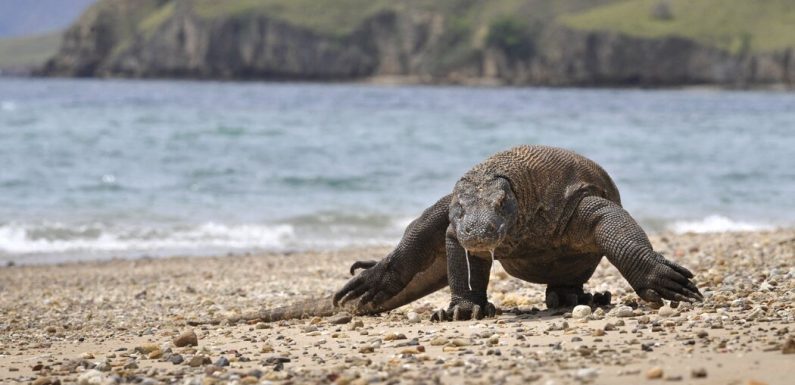
The Komodo dragon has earned its status as a reptilian icon.
The carnivorous lizard can grow up to 10 feet long and is equipped with a forked tongue, serrated teeth, armored scales and venom-laced saliva. The dragons can detect flesh from miles away while hunting an impressive array of prey, including deer, boars, horses, water buffalo — and one another. Females are even known to eat their own offspring.
“It’s got this fearsome reputation,” said Craig Hilton-Taylor, a biologist with the International Union for Conservation of Nature. “It’s like seeing your storybooks come alive.”
But now, the world’s largest living lizard has moved one step closer to being wiped out in the wild.
Komodo dragons, previously considered a “vulnerable” species, were reclassified last weekend as “endangered” by the conservation organization.
“It’s had a genuine change in status, a deterioration,” said Mr. Hilton-Taylor, head of the international group’s Red List unit, which assesses the conservation risk of 138,000 species and counting. “It’s moving toward extinction.”
The new label is intended to spur international policymakers and conservation groups to strengthen and expand protections for the giant lizard in its natural habitats. That may be especially necessary among a population of the dragons that live in areas that are not protected and that are more vulnerable to activities such as illegal hunting and habitat clearance.
“It rings the alarm bells more loudly,” said Andrew Terry, a conservation director at the Zoological Society of London. “It increases the urgency to act.”
Komodo dragons are native to Indonesia and found in the country’s Komodo National Park, a UNESCO world heritage site that includes the namesake island and a number of other islands. A more poorly understood population of the species also lives on Flores, a larger, neighboring island.
While experts consider the national park’s Komodo dragon population to be stable and well-protected, the species still faces mounting obstacles to its long-term survival. Komodo dragons are particularly vulnerable to environmental changes because they inhabit a limited belt of land between the islands’ coasts and steep forested hills.
“They’re quite tight, in terms of where they can live,” said Gerardo Garcia, a conservation biologist at the Chester Zoo in England who has spent almost a decade working with Komodo dragon protection efforts in Indonesia.
The International Union for Conservation of Nature warns that suitable Komodo dragon habitat is expected to shrink by at least 30 percent in the next 45 years. Factors driving this habitat loss include the rising temperatures and sea levels associated with climate change. But outside of the dragons’ park safe haven, urbanization and agricultural clearing are also factors. On Flores, residents compete with the dragons for deer and boars as well, and consider the carnivorous lizards a threat to cattle, goats and other livestock.
Latest Updates
“These animals get persecuted,” Dr. Garcia said. Despite their global charisma, he said, “they do not have a magic shield.”
Their ranks have already experienced a steep decline. About 25 years ago, somewhere from 5,000 to 8,000 Komodo dragons roamed the Earth. Today, the I.U.C.N. estimates that there are just 1,380 adult Komodo dragons and another 2,000 juveniles left in the wild. “The real concern is what’s going to happen in the future,” Mr. Hilton-Taylor said.
Other reptilian species — many of which are also isolated on islands — are vulnerable to the same threats. “It’s a flagship for the state of reptiles worldwide,” Dr. Terry said.
If Komodo dragons drop past a critically endangered status, they could become what’s known as “extinct in the wild,” and survive only in captivity. “I think that would be an awful indictment,” he said. “Nobody working in a zoo is happy to see a species only existing in a zoo.”
Dr. Garcia likened the recent reclassification to entering an emergency room. “If we don’t react quickly, we’re going to have very few animals,” he said. “That means you go to intensive care.”
At that point, the only hope for Komodo dragons would be a precarious one: a captive breeding program and attempted transplants to limited and fragmented wild habitats. But experts say it hasn’t come to that — yet.
“This is the last chance,” Dr. Garcia said. “We still have a bit of time.”
Source: Read Full Article